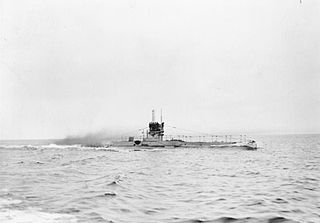HMS E51 was a British E class submarine built originally from Yarrow, Scotstoun, but transferred to Scotts, Greenock on 3 March 1915. HMS E51 was launched on 30 November 1916 and commissioned on 27 January 1917. E51 was sold for scrap on 13 October 1921.
HMS E56 was a British E-class submarine built by William Denny, Dumbarton. She was laid down on 1 December 1914, launched 19 June 1916 and was commissioned on 8 August 1916. E56 was sold for scrap at Granton, Edinburgh, on 9 June 1923.

HMS E55 was a British E class submarine built by William Denny, Dumbarton. She was launched on 5 February 1916 and was commissioned in March 1916. E55 was sold for scrap at Newcastle on 6 September 1922.
HMS E54 was a British E class submarine built by William Beardmore, Dalmuir. She was laid down on 1 February 1915 and was commissioned in May 1916. She sank UC-10 on 21 August 1916 and U-81 on 1 May 1917. E54 was sold for scrap on 14 December 1921.

HMS E17 was a British E-class submarine built by Vickers, Barrow-in-Furness. She was laid down on 29 July 1914, launched on 16 January 1915 and was commissioned on 7 April 1915. HMS E17 was wrecked off Texel in the North Sea on 6 January 1916. Her crew were rescued by a Dutch cruiser Noordbrabant. They were interned. The conning tower of E17 is preserved as a monument at the Royal Navy Submarine Museum in Gosport, the United Kingdom.
HMS E21 was a British E class submarine built by Vickers, Barrow-in-Furness. She was launched on 24 July 1915 and commissioned on 1 October 1915. E21 was sold on 14 December 1921.
HMS E53 was a British E class submarine built by William Beardmore and Company, Dalmuir. She was launched in 1916 and was commissioned in March 1916. E53 was sold for scrap on 6 September 1922.
HMS E48 was a British E class submarine launched by Fairfield Shipbuilding and Engineering Company, Govan in 1916 and was completed by William Beardmore and Company, Dalmuir. She was launched on 2 August 1916 and was commissioned in February 1917.
HMS E27 was a British E class submarine built by Yarrow Shipbuilders, Scotstoun. She was launched on 9 June 1917 and commissioned in August 1917. HMS E27 was sold to John Cashmore Ltd in Newport for scrapping on 6 September 1922.

HMS E30 was a British E-class submarine built by Armstrong Whitworth, Newcastle upon Tyne. She was laid down on 29 June 1914 and was commissioned in November 1915. HMS E30 was lost in the North Sea, thought to have been mined off Orfordness, Suffolk on 22 November 1916, the minefield was not discovered until 25 November. There were no survivors.
HMS E33 was a British E class submarine built by John Thornycroft, Woolston, Hampshire. She was launched on 18 April 1916 and was commissioned in November 1916. E33 was sold to John Cashmore Ltd for scrapping at their yard in Newport on 6 September 1922.

HMS E34 was a British E class submarine built by John Thornycroft, Woolston, Hampshire. She was launched on 27 January 1917 and commissioned in March 1917. HMS E34 sank the U-boat UB-16 off Harwich in the North Sea on 10 May 1918. E34 was mined near the Eijerlandse Gronden, the sands between the Frisian islands Texel and Vlieland on 20 July 1918. There were no survivors.
HMS E46 was a British E class submarine built by Cammell Laird, Birkenhead. She was launched on 4 April 1916 and was commissioned in October 1916. HMS E46 was sold in South Wales on 6 September 1922.
HMS E35 was a British E class submarine built by John Brown, Clydebank. She was launched on 20 May 1916 and commissioned on 14 July 1917. E35 sank U-154 off the island of Madeira on 11 May 1918. This sinking was helped by British intelligence who had learned of a planned rendezvous between two U-boats off Cape St Vincent. E35 was sold in Newcastle on 6 September 1922.
HMS E36 was an E-class submarine built by John Brown, Clydebank for the Royal Navy. She was laid down on 7 January 1915 and was commissioned on 16 November 1916.
HMS E37 was a British E class submarine built by Fairfield, Govan, Clyde. She was launched on 2 September 1915 and commissioned on 17 March 1916. E37 was lost in the North Sea on 1 December 1916. There were no survivors.

HMS E42 was a British E-class submarine built by Cammell Laird, Birkenhead. She was launched on 22 October 1915 and commissioned in July 1916. She served during the First World War, hitting with a torpedo the battlecruiser SMS Moltke on 25 April 1918 and making an unsuccessful attack on U-92 on 1 July 1918. E42 was sold for scrap at Poole on 6 September 1922.

HMS E43 was a British E class submarine built by Swan Hunter, Wallsend. She was laid down on 22 December 1914 and was commissioned on 20 February 1916. On 19 January 1917 E43 collided with E36 off Harwich in the North Sea; E36 sank with all hands. E43 was sold on 3 January 1921 but became stranded under tow west off St Agnes Head, Cornwall on 25 November 1921.
HMS E44 was a British E class submarine built by Swan Hunter, Wallsend. She was laid down on 8 January 1916 and was commissioned on 18 July 1916. E44 was sold for scrap in South Wales on 13 October 1921.
HMS E45 was a British E class submarine built by Cammell Laird, Birkenhead. She was launched on 25 January 1916 and was commissioned in August 1916. E45 torpedoed U-boat UC-62 in the North Sea on 15 October 1917. E45 was sold in South Wales on 6 September 1922.








